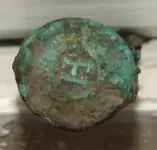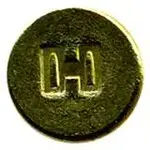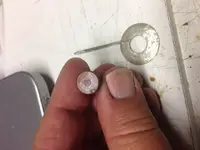This is about as big around as a 38 shell or pretty close to it. It looks to be a casing of some sort. Maybe rimfire. As you can see from the picture it looks like it has an H on it. Thanks.
You are using an out of date browser. It may not display this or other websites correctly.
You should upgrade or use an alternative browser.
You should upgrade or use an alternative browser.
Help with ID on this bullet casing?
- Thread starter Bill_S
- Start date
Almy
Bronze Member
- Joined
- Mar 18, 2011
- Messages
- 1,596
- Reaction score
- 3,018
- Golden Thread
- 0
- Location
- Maritime Provinces
- Detector(s) used
- Tesoro Cibola
- Primary Interest:
- Other
"H" could stand for "Henry," the forerunner of Winchester and used on Winchester ammunition.
Upvote
0
Sheldon J
Hero Member
- Joined
- Jul 18, 2009
- Messages
- 897
- Reaction score
- 600
- Golden Thread
- 0
- Location
- Battle Creek, Mi
- Detector(s) used
- Mine lab, Garrett, Bounty Hunter,
can you measure the dia of the base? From what you have described so far would be a .38 / 40 bit as I remember correctly the early Henry's were .44 / 40 rim fire, and although at the time considered somewhat of an anemic round made up for it by the riffles capacity.
Upvote
0
allan
Hero Member
prolly wouldn't help if its that bad, I know there was a 32 and a 41 rimfire and a .38 and a .44 looks like a hornady headstamp , try this link http://www.oldammo.com/july04.htm
Attachments
Upvote
0
CC Hunter
Hero Member
The casing is most certainly a .44 cal. Henry. The Henry rifle employed a double firing pin, leaving two marks on opposite sides of the rim. The purpose of the double firing pin, was to reduce the "miss-fires" caused by a firing pin striking a void (an area inside the rim that was without primer). In manufacturing the cartridges at that time, there was difficulty in consistent flow of the primer material around the entire inner rim area. Therefor, in designing the rifle that bears his namesake, Mr. Henry employed the dual firing pins, to increase the odds that at least one pin would hit a potent primer pocket (purposeful pun play  ).
).
Additionally all fired Henry casings, exhibit a raised bulge on the casing head (caused by the expansion of the weak brass casing head, into the rifle breach). On the example shown here, we may also note it has been struck multiple times in an effort to fire, (a good case in point, to the poor primer issue mentioned earlier).
CC Hunter
 ).
).Additionally all fired Henry casings, exhibit a raised bulge on the casing head (caused by the expansion of the weak brass casing head, into the rifle breach). On the example shown here, we may also note it has been struck multiple times in an effort to fire, (a good case in point, to the poor primer issue mentioned earlier).
CC Hunter
Upvote
0
TheCannonballGuy
Gold Member
- Joined
- Feb 24, 2006
- Messages
- 6,607
- Reaction score
- 13,455
- Golden Thread
- 0
- Location
- Occupied CSA (Richmond VA)
- Detector(s) used
- White's 6000, Nautilus DMC-1, Minelab
- Primary Interest:
- Relic Hunting
CC Hunter, what you said is exactly what I noticed about it. (Dual firing-pin, etc.) But the digger (Bill_S) said "it is about 1 1/2 inches long." That is almost twice as long as a .44 Henry rimfire casing. (I've dug dozens of those, with the raised "H" headstamp, and my calipers say those casings are only .85-inch long. So, based on Bill_S's report of his casing's length, I discarded the possibility of a .44 Henry rimfire as the object's ID. I confess my main area of study has been civil war era projectiles, though I've learned a fair amount about Indian Wars (and later) bullets ...see the Custer reference below. I'm not aware of a 1.5"-long .44 Henry rimfire casing. If such a thing exists, please put me onto the info about it.
Bill_S, you asked "how old?" The .44 Henry Rifle rimfire cartridge was in service from the civil war into the late 1870s. (If I recall correctly, some of Custer's troopers had them at the Battle of Little Bighorn, in 1876.) Its manufacturer, New Haven Arms Company, sold many of them to the American public, for use in hunting.
Edit: The .44 Henry Rifle was never officially adopted by the US Army.
Bill_S, you asked "how old?" The .44 Henry Rifle rimfire cartridge was in service from the civil war into the late 1870s. (If I recall correctly, some of Custer's troopers had them at the Battle of Little Bighorn, in 1876.) Its manufacturer, New Haven Arms Company, sold many of them to the American public, for use in hunting.
Edit: The .44 Henry Rifle was never officially adopted by the US Army.
Upvote
0
TheCannonballGuy
Gold Member
- Joined
- Feb 24, 2006
- Messages
- 6,607
- Reaction score
- 13,455
- Golden Thread
- 0
- Location
- Occupied CSA (Richmond VA)
- Detector(s) used
- White's 6000, Nautilus DMC-1, Minelab
- Primary Interest:
- Relic Hunting
Please post a close-up "sideview" photo of the casing. Also, please measure the diameter of the casing's flat base as precisely as possible. The precise measurement is crucial for figuring out your casing's caliber. The flat-base diameter measurement for my dug civil war .44 Henry rimfire casings is .52-inch.
Upvote
0
CC Hunter
Hero Member
Professor Cannonball Guy,
Your observation on the length characteristics, presents an odd specimen for our review.
I've dug literally hundreds, if not thousands of .44 cal. Henry casings and cartridges, and I will concur that the lengths are certainly not as long as the 1.25" plus listed for the example here. Winchester continued the "H" head-stamp for many years, and this was used a wide range of cartridges of various caliber. However, the raised bulge is usually a dead give-away for a fired Henry casing (the bulge is not present on unfired cartridges). Furthermore, there were other companies manufacturing .44 cal. rim-fire cartridges for use in Henry and Winchester rifles, consequently there are fired casings found with the firing pin configuration from a Henry rifle, along with the head bulge, and yet the markings are other than an "H". So, from this we learn that not all Henry casings have the "H" head-stamp, and also not all "H" head-stamped cartridges and casing are Henry's. Confusing........Huh?
There are a couple fellows with extensive expertise in not only identifying cartridges and casing, but also the exact rifle model that fired these, based on the firing pin marks (Wild West CSI). I will try to contact one very knowledgeable fellow in this field.
In regards to the Battle of the Little Bighorn, there were indeed many Henry rifles in use. In fact, scores of Henry casings were recovered during acheaological excavations, and used to plot positions, and track certain battle movements. However, most of Custer's troops were in fact utilizing single-shot .45-.70 Springfield carbines (government pencil pushers claimed the repeating rifles wasted ammo.....?) The more reliable Henry repeating rifles, were in fact, predominantly wielded by the Sioux.
CC Hunter
Your observation on the length characteristics, presents an odd specimen for our review.
I've dug literally hundreds, if not thousands of .44 cal. Henry casings and cartridges, and I will concur that the lengths are certainly not as long as the 1.25" plus listed for the example here. Winchester continued the "H" head-stamp for many years, and this was used a wide range of cartridges of various caliber. However, the raised bulge is usually a dead give-away for a fired Henry casing (the bulge is not present on unfired cartridges). Furthermore, there were other companies manufacturing .44 cal. rim-fire cartridges for use in Henry and Winchester rifles, consequently there are fired casings found with the firing pin configuration from a Henry rifle, along with the head bulge, and yet the markings are other than an "H". So, from this we learn that not all Henry casings have the "H" head-stamp, and also not all "H" head-stamped cartridges and casing are Henry's. Confusing........Huh?

There are a couple fellows with extensive expertise in not only identifying cartridges and casing, but also the exact rifle model that fired these, based on the firing pin marks (Wild West CSI). I will try to contact one very knowledgeable fellow in this field.
In regards to the Battle of the Little Bighorn, there were indeed many Henry rifles in use. In fact, scores of Henry casings were recovered during acheaological excavations, and used to plot positions, and track certain battle movements. However, most of Custer's troops were in fact utilizing single-shot .45-.70 Springfield carbines (government pencil pushers claimed the repeating rifles wasted ammo.....?) The more reliable Henry repeating rifles, were in fact, predominantly wielded by the Sioux.
CC Hunter
Upvote
0
TheCannonballGuy
Gold Member
- Joined
- Feb 24, 2006
- Messages
- 6,607
- Reaction score
- 13,455
- Golden Thread
- 0
- Location
- Occupied CSA (Richmond VA)
- Detector(s) used
- White's 6000, Nautilus DMC-1, Minelab
- Primary Interest:
- Relic Hunting
CC Hunter, you and I have been following the same path in our research on Bill_S's casing.  I'll add a few other points of information, for any of the forum's readers who are interested.
I'll add a few other points of information, for any of the forum's readers who are interested.
The sole manufacturer of the .44 Henry Repeating Rifle was the New Haven (Connecticut) Arms Company. Its primary stockholder and director, Oliver Winchester, reorganized the company in 1866 and changed its name to the Winchester Repeating Arms Company. Also in 1866, that company began producing its improved version of the Henry, calling its new product the Model 1866 Winchester .44 Repeating Rifle. It was originally chambered to use the existing (civil war era) .44 Henry cartridge ...whose casing-length was .85"-to-.89", according to various info-sources.
Apparently because the "H" headstamp marking on those cartridges indicated "quality" ammunition to its customers, Winchester continued to use the H headstamp on its rimfire cartridges for many decades ...even on other calibers of rimfire cartridges. For example, there is a slightly-postwar Spencer .56 cartridge which has the "raised" H headstamp.
Sometime around 1880, Winchester switched from the raised-H mark to a simpler "depressed" H mark.
Now, about Bill_S's mysterious 1.25"-long rimfire casing with a raised-H mark-in-a-depressed-circle and "dual firing-pin" impression:
My research has turned up only three 19th-Century firearms which had a dual firing-pin. They are the .44 Henry Rifle, the Model 1866 Winchester .44 Rifle/Carbine, and the Swiss Vetterli 10.4mm Repeating Rifle (known in the US as a ".41 Swiss").
By the way... the Winchester .44 Model-1873 Rifle/Carbine used the .44-40 cartridge, which was strictly a centerfire, so that can't be Bill's casing. Also, the Winchester Model-1873 used a typical single firing-pin, so Bill's casing wasn't fired in that weapon.
Bill's "long" casing could not have been loading into a .44 Henry Rifle, so we can exclude that firearm as a possibility for Bill's casing. The .41 Vetterli's casing was specified to be 38mm (1.5-inch) long, so I think Bill's 1.25"-long casing would not have been used in a Vetterli.
Having eliminated the other possibilities, it seems Bill's 1.25"-long casing was fired in a Winchester Model-1866.
If I recall correctly, the US National Park Service's archeological report on casings excavated from the Custer battlefield mentions 'Short" and "Long" .44 casings with dual firing pin marks. Unfortunately, that report does not show "sideview" photos of those casings (just baseview photos). As you know, I don't mind sharing my research, so if you'd like to view that very extensive report and its photos (with lots of other Custer Battlefield cartridge and firing-pin info), go here, to see the 4.08-megabyte .pdf document: http://www.nps.gov/mwac/publications/pdf/tech94b.pdf
At the moment, as we wait for more photos and precise measurement of the casing's "head" from Bill_S, I can only guess that the casing is a "long" .44 made by Winchester for use in the Model-1866 Winchester Repeater.
 I'll add a few other points of information, for any of the forum's readers who are interested.
I'll add a few other points of information, for any of the forum's readers who are interested.The sole manufacturer of the .44 Henry Repeating Rifle was the New Haven (Connecticut) Arms Company. Its primary stockholder and director, Oliver Winchester, reorganized the company in 1866 and changed its name to the Winchester Repeating Arms Company. Also in 1866, that company began producing its improved version of the Henry, calling its new product the Model 1866 Winchester .44 Repeating Rifle. It was originally chambered to use the existing (civil war era) .44 Henry cartridge ...whose casing-length was .85"-to-.89", according to various info-sources.
Apparently because the "H" headstamp marking on those cartridges indicated "quality" ammunition to its customers, Winchester continued to use the H headstamp on its rimfire cartridges for many decades ...even on other calibers of rimfire cartridges. For example, there is a slightly-postwar Spencer .56 cartridge which has the "raised" H headstamp.
Sometime around 1880, Winchester switched from the raised-H mark to a simpler "depressed" H mark.
Now, about Bill_S's mysterious 1.25"-long rimfire casing with a raised-H mark-in-a-depressed-circle and "dual firing-pin" impression:
My research has turned up only three 19th-Century firearms which had a dual firing-pin. They are the .44 Henry Rifle, the Model 1866 Winchester .44 Rifle/Carbine, and the Swiss Vetterli 10.4mm Repeating Rifle (known in the US as a ".41 Swiss").
By the way... the Winchester .44 Model-1873 Rifle/Carbine used the .44-40 cartridge, which was strictly a centerfire, so that can't be Bill's casing. Also, the Winchester Model-1873 used a typical single firing-pin, so Bill's casing wasn't fired in that weapon.
Bill's "long" casing could not have been loading into a .44 Henry Rifle, so we can exclude that firearm as a possibility for Bill's casing. The .41 Vetterli's casing was specified to be 38mm (1.5-inch) long, so I think Bill's 1.25"-long casing would not have been used in a Vetterli.
Having eliminated the other possibilities, it seems Bill's 1.25"-long casing was fired in a Winchester Model-1866.
If I recall correctly, the US National Park Service's archeological report on casings excavated from the Custer battlefield mentions 'Short" and "Long" .44 casings with dual firing pin marks. Unfortunately, that report does not show "sideview" photos of those casings (just baseview photos). As you know, I don't mind sharing my research, so if you'd like to view that very extensive report and its photos (with lots of other Custer Battlefield cartridge and firing-pin info), go here, to see the 4.08-megabyte .pdf document: http://www.nps.gov/mwac/publications/pdf/tech94b.pdf
At the moment, as we wait for more photos and precise measurement of the casing's "head" from Bill_S, I can only guess that the casing is a "long" .44 made by Winchester for use in the Model-1866 Winchester Repeater.
Upvote
0
TheCannonballGuy
Gold Member
- Joined
- Feb 24, 2006
- Messages
- 6,607
- Reaction score
- 13,455
- Golden Thread
- 0
- Location
- Occupied CSA (Richmond VA)
- Detector(s) used
- White's 6000, Nautilus DMC-1, Minelab
- Primary Interest:
- Relic Hunting
July 4th 9:30 PM (EDST) update:
I found the info and photos I've been searching for, about "short" and "long" Henry/Winchester rimfire-primer .44 cartridges with a raised-H headstamp marking in a depressed circle (like Bill_S dug). They continued to be manufactured for years after the end of the civil war, for use in .44 Henry and Model-1886 Winchester rifles/carbines. Go to: http://www.oldammo.com/november07.htm
I should mention that none of the photos show a civil war era version of the bullet ...just postwar (1866 and later) versions.
According to the oldammo.com website, "It should be pointed out that a cartridge used in the Henry and Winchester Model 1866 rifles cannot have an overall length of more than about 1 3/8". Beyond this length, the cartridge cannot be lifted up to chambering position by the rifle's carrier."
So, although the length of the copper casing may vary, the maximum length of the complete catridge (which includes the lead bullet) is 1-&-3/8-inch. That's because even in the "Flat" (flat-tipped bullet) version the lead bullet is exposed by about 3/8-inch; thus, the copper casing's maximum length can be no more than 1.0-inch long. This info appears to mean that both of the length-measurements reported by Bill_S (originally stated as 1.5" and then revised to 1.25") are incorrect ...or that his casing is not a .44-caliber Henry/Winchester casing. But if it's not, how did it get the distinctive .44 Henry/Winchester-1866 dual-firing-pin marks? Crushing the casing's cylindrical body cannot extend its length.
I found the info and photos I've been searching for, about "short" and "long" Henry/Winchester rimfire-primer .44 cartridges with a raised-H headstamp marking in a depressed circle (like Bill_S dug). They continued to be manufactured for years after the end of the civil war, for use in .44 Henry and Model-1886 Winchester rifles/carbines. Go to: http://www.oldammo.com/november07.htm
I should mention that none of the photos show a civil war era version of the bullet ...just postwar (1866 and later) versions.
According to the oldammo.com website, "It should be pointed out that a cartridge used in the Henry and Winchester Model 1866 rifles cannot have an overall length of more than about 1 3/8". Beyond this length, the cartridge cannot be lifted up to chambering position by the rifle's carrier."
So, although the length of the copper casing may vary, the maximum length of the complete catridge (which includes the lead bullet) is 1-&-3/8-inch. That's because even in the "Flat" (flat-tipped bullet) version the lead bullet is exposed by about 3/8-inch; thus, the copper casing's maximum length can be no more than 1.0-inch long. This info appears to mean that both of the length-measurements reported by Bill_S (originally stated as 1.5" and then revised to 1.25") are incorrect ...or that his casing is not a .44-caliber Henry/Winchester casing. But if it's not, how did it get the distinctive .44 Henry/Winchester-1866 dual-firing-pin marks? Crushing the casing's cylindrical body cannot extend its length.
Upvote
0
TheCannonballGuy
Gold Member
- Joined
- Feb 24, 2006
- Messages
- 6,607
- Reaction score
- 13,455
- Golden Thread
- 0
- Location
- Occupied CSA (Richmond VA)
- Detector(s) used
- White's 6000, Nautilus DMC-1, Minelab
- Primary Interest:
- Relic Hunting
Update July 4th 10:15 PM (EDST):
Here's a photo of a box of .44 "Flat" cartridges made for use in the Winchester Model-1866 Rifle. The label on the box indicates this ammo was manufacured in March 1913! Note that the label's illustration of the cartridge shows its headstamp-marking is a depressed letter H (not the raised-H).
Sidenote, for anybody here who wants to learn more about identifying the time-period of bullets:
Also, note that the lead bullet has a cannelure (encircling groove) which is "reeded" ...meaning, the groove contains many short parallel lines. "Reeded" cannelures/grooves on bullets first began appearing in the latter 1800s era. Many modernday bullets also have reeded cannelures/grooves. The drawing on the ".44 Flat" Winchester cartridge box may not be sufficiently educational to some people's eyes, so I'll include a second photo, showing a mid-20th-century bullet with a reeded cannelure/groove.
Here's a photo of a box of .44 "Flat" cartridges made for use in the Winchester Model-1866 Rifle. The label on the box indicates this ammo was manufacured in March 1913! Note that the label's illustration of the cartridge shows its headstamp-marking is a depressed letter H (not the raised-H).
Sidenote, for anybody here who wants to learn more about identifying the time-period of bullets:
Also, note that the lead bullet has a cannelure (encircling groove) which is "reeded" ...meaning, the groove contains many short parallel lines. "Reeded" cannelures/grooves on bullets first began appearing in the latter 1800s era. Many modernday bullets also have reeded cannelures/grooves. The drawing on the ".44 Flat" Winchester cartridge box may not be sufficiently educational to some people's eyes, so I'll include a second photo, showing a mid-20th-century bullet with a reeded cannelure/groove.
Attachments
-
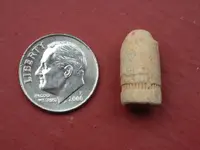 bullet_POSTWAR_reeded-groove_dime-for-size_photobyBebo_DSCN0240_855x642.webp41.3 KB · Views: 1,895
bullet_POSTWAR_reeded-groove_dime-for-size_photobyBebo_DSCN0240_855x642.webp41.3 KB · Views: 1,895 -
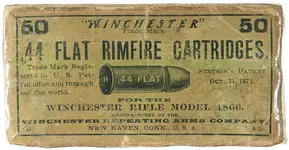 cartridge_POSTWAR_44flat-rimfire-for-Winchester1866rifle_made-in-March1913.webp203.9 KB · Views: 2,561
cartridge_POSTWAR_44flat-rimfire-for-Winchester1866rifle_made-in-March1913.webp203.9 KB · Views: 2,561 -
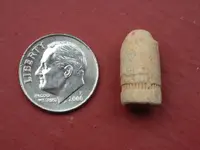 bullet_POSTWAR_reeded-groove_dime-for-size_photobyBebo_DSCN0240_855x642.webp41.3 KB · Views: 436
bullet_POSTWAR_reeded-groove_dime-for-size_photobyBebo_DSCN0240_855x642.webp41.3 KB · Views: 436
Upvote
0
Similar threads
- Replies
- 5
- Views
- 694
Users who are viewing this thread
Total: 1 (members: 0, guests: 1)



